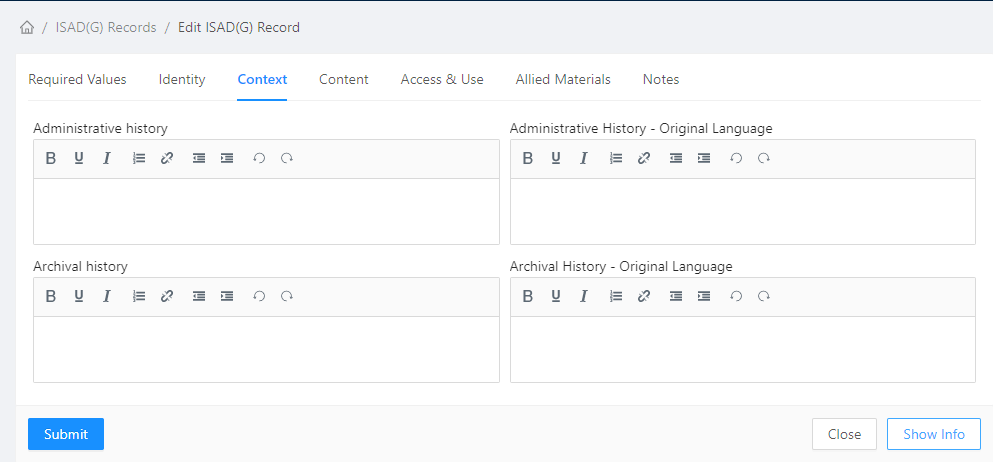Context Tab

Administrative history
Standard Reference: ISAD(G) 3.2.2 Format: Free text. Purpose: To provide an administrative history of, or biographical details on the creator (or creators) of the unit of description to place the material in context and make it better understood. Rule: Record concisely any significant information on the origin, progress, development, and work of the organization (or organizations) or on the life and work of the individual (or individuals) responsible for the creation of the unit of description. If additional information is available in a published source, cite the source. ISAD(G) General International Standard Archival Description, Second Edition. The Information Areas of ISAAR(CPF) suggest specific informational elements that may be included in this element. For persons or families record information such as full names and titles, dates of birth and death, place of birth, successive places of domicile, activities, occupation or offices, original and any other names, significant accomplishments, and place of death. Example: Helen Lucas, the Canadian artist, was born in 1931 in Weyburn, Saskatchewan, studied at the Ontario College of Art (Toronto) from 1950-1954, and was a Drawing and Painting Master at Sheridan College (Oakville, Ont.) from 1973-1979. She has exhibited her artworks widely in Canadian cities. She works from her Gallery in King City. In 1991 York University awarded her a Doctor of Letters (Honoris Causa). (Fonds) Canada, York University Archives
Administrative history - Original Language
Standard Reference: ISAD(G) 3.2.2 Format: Free text. Purpose: If the description of the archival unit is chosen to be bilingual, this field facilitates providing an administrative history of or biographical details on the creator (or creators) of the unit of description in the original (non-English) language to place the material in context and make it better understood. Rule: If the description of the archival unit is chosen to be bilingual, this field facilitates recording concisely any significant information in the original (non-English) language on the origin, progress, development, and work of the organization (or organizations) or on the life and work of the individual (or individuals) responsible for the creation of the unit of description. If additional information is available in a published source, cite the source. ISAD(G) General International Standard Archival Description, Second Edition. The Information Areas of ISAAR(CPF) suggest specific informational elements that may be included in this element. For persons or families record information such as full names and titles, dates of birth and death, place of birth, successive places of domicile, activities, occupation or offices, original and any other names, significant accomplishments, and place of death.
Read more on Languages and Multilingualism.
Archival history
Standard Reference: ISAD(G) 3.2.3 Format: Free text Purpose: To provide information on the history of the unit of description that is significant for its authenticity, integrity, and interpretation. Rule: Record the successive transfers of ownership, responsibility, and/or custody of the unit of description and indicate those actions, such as the history of the arrangement, production of contemporary finding aids, re-use of the records for other purposes or software migrations, that have contributed to its present structure and arrangement. Give the dates of these actions, insofar as they can be ascertained. If the archival history is unknown, record that information. Optionally, when the unit of description is acquired directly from the creator, do not record an archival history but rather, record this information as the Immediate source of acquisition. (See following rule). Example: After the death of Rodolf Hervé in 2000, the Hi8 video recordings were transferred to the custody of Lucien and Judith Hervé (parents of Rodolf Hervé) by colleague and cameraman Tamás Szűcs. The Hervé family donated them to C³ Center for Culture & Communication Foundation (Budapest, Hungary), where they were digitized into DVD format. On the Hervé family's request, these DVDs were copied and the copies were transferred to and deposited with the OSA Archivum in 2004. In 2012, the DVD format files were converted into MPEG-4 files.
Archival history - Original Language
Standard Reference: ISAD(G) 3.2.3 Format: Free text Purpose: If the description of the archival unit is chosen to be bilingual, this field facilitates providing information on the history of the unit of description that is significant for its authenticity, integrity, and interpretation in the original (non-English) language. Rule: If the description of the archival unit is chosen to be bilingual, this field facilitates the record of the successive transfers of ownership, responsibility, and/or custody of the unit of description and indicates those actions, such as the history of the arrangement, production of contemporary finding aids, re-use of the records for other purposes or software migrations, that have contributed to its present structure and arrangement. Give the dates of these actions, insofar as they can be ascertained. If the archival history is unknown, record that information. This has to be done in the original (non-English) language of the description. Optionally, when the unit of description is acquired directly from the creator, do not record an archival history but rather, record this information as the Immediate source of acquisition. (See following rule). Example: A Fekete Doboz Alapítvány és a Nyílt Társadalom Archívum az OSA 1995-ös megalapítása óta kapcsolatban állt egymással. A felbecsülhetetlen értékű és egyedülálló videó- és textuális anyag első szállítmánya 2011-ben került az OSA-ba, amikor a Fekete Doboz 90 rövid dokumentumfilmjét, az 1989-es Ellenzéki Kerekasztal Tárgyalásokat dokumentáló videófelvételeit és ezek elektronikus átiratait, a Magyar Televízió által 1989-ben gyártott és sugárzott hír- és egyéb politikai műsorokat, illetve a Fekete Doboz 1988-89-ben készített nyers, vágatlan filmjeit adta át az OSA-nak. További szállítmányok érkeztek 2012 és 2015 között, köztük a felbecsülhetetlen értékű 1988 és 2008 között forgatott kamera eredeti, nyers és vágatlan videók, a hozzájuk kapcsolódó szkriptlisták, valamint a Fekete Doboz összes vágott dokumentumfilmje.

